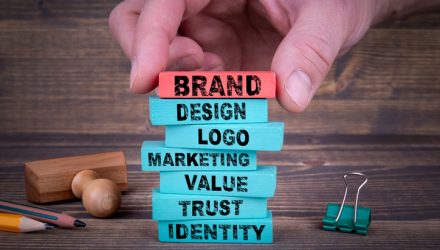Earnings season has always been a rude reminder that quarterly reports can be deceiving as companies take advantage of creative bookkeeping practices. Earnings season has always been a rude reminder that quarterly reports can be deceiving as companies take advantage of creative bookkeeping practices.
What’s more problematic than ever before is that companies today are increasingly valued based on their intangible assets, including brand, trademarks, and intellectual property, which isn’t even covered by GAAP (generally accepted accounting principles).
To put this discrepancy into perspective, consider this seismic shift: in 1975, intangible assets represented just 17% of the S&P 500 companies’ market value; today, intangibles account for 84% of the S&P 500’s market value.
Susan Avarde, Co-Founder & Chief Strategist of Brandometry, the index behind the Brand Value ETF (BVAL), spoke with ETF Trends to discuss the overlooked significance of Corporate boards, financial analysts, and the SEC beginning to tackle the implications of having over $8 trillion in intangible value that is “off the books”.
What is the overlooked importance of Brand Value, a subset of intangibles, which accounts for 14-21% of intangible value?
Brand Value as an asset needs to be actively measured because without it, a very significant corporate asset is vulnerable to erosion. As many management consultants say, “if you don’t measure it, you can’t manage it”. Current accounting standards provide little information about the value of brand-related assets, and while companies can report the value of acquired brands such as Gillette (P&G) there is currently no systematic way to value internally built brands. Kellogg’s, for example, has recognized the value of Pringles, an acquired brand, but cannot report or include the market value for its internally created brand, Kellogg’s Corn Flakes. When you leave brand measures out of any calculation, you miss a critical opportunity to protect and grow one of the most important revenue drivers.
What are the challenges with measuring Brand Value; examples of how to do it correctly and consistently?
There are two challenges with measuring Brand Value. The first is a lack of a systematized regulated approach and the second is consistency of data collection. In absence of a mandated approach, other methods have been devised over the past 20 years, but they all have major drawbacks. The challenges with these approaches are twofold. Firstly, they are calculated using rather black box methods with publicly available financials, but this can result in wildly ranging outcomes. Secondly, there is an issue with the consistency of tracking. Companies can fall out of a database resulting in gaps in the vintages, so the databases are rarely comprehensive.
At Brandometry, we place a high value on consistency and use the CoreBrand® Index, which tracks 500 brands and has measured the perception of brands for over 25 years. The research tracks 3 elements of brand strength:
- Management team
- Brand reputation
- Likelihood of the respondent to invest
These strengths are scored on a 1-100 scale enabling us to identify powerful brands which are undervalued.
What are the latest regulatory efforts worldwide to create a methodology for putting intangibles “on the books”?
Three years ago, the SEC invited suggestions on how companies should record their intangible assets, including brands. At the same time The Financial Accounting Standards Board (FASB) also acknowledged the need to provide better accuracy and guidance on intangible assets, and considered it one of the top issues to be addressed. In response to accounting shortcomings, the American National Standards Institute (ANSI) and the Licensing Executives Society (LES) will publish a standard for the internal assessment of, and reporting on, intangibles and brand in 2020. The expectation is that once a few companies start sharing such information, it is predicted that investors will put pressure on peer companies to start disclosing similar statistics, thereby driving change. This is a global conversation and if the USA adopts the new standard it will lead the world.
What is the risk of relying on traditional valuation metrics going forward?
Relying on any of the traditional valuation methods listed above is risky because it is unwise to rely on an external measure (often rendered by a consultancy or communications firm) to size one of your significant assets. Also, CFOs will begin to ask questions regarding intangible value and many corporations run the risk of being unprepared to answer. Lastly, and perhaps more importantly, CEOs will now need to report intangible value to the board as part of an acquisition or divestiture. Questions regarding brand value and brand investment are now very high up the corporate ladder and the pace of change will pick up when investors join in asking the same questions as the board.
Brandometry’s three founders Larry Medin, Susan Avarde and Tony Wenzel, bring a broad range of expertise from the world’s of finance, brand, and tech. Brandometry created the EQM Brand Value Index, a core, thematic investment index using qualitative brand signals to identify undervalued strong brands. The index can be accessed through an SMA or 40 Act Fund. www.brandometry.net.


